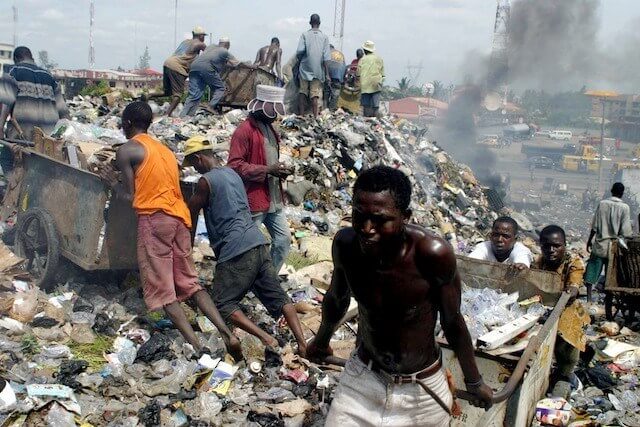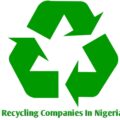Nigeria, with population exceeding 170 million, is one of the largest producers of solid waste in Africa. Nigeria generates more than 32 million tons of solid waste annually, out of which only 20-30% is collected. Reckless disposal of MSW has led to blockage of sewers and drainage networks, and choking of water bodies.
Waste disposal, the collection, processing, and recycling or deposition of the waste materials of human society. Waste is classified by source and composition. Broadly speaking, waste materials are either liquid or solid in form, and their components may be either hazardous or inert in their effects on health and the environment. The term waste is typically applied to solid waste, sewage (wastewater), hazardous waste, and electronic waste.
In industrialized countries, municipal liquid waste is funneled through sewage systems, where it undergoes wastewater treatment, or sewage treatment. This process removes most or all of the impurities from wastewater, or sewage, before they can reach groundwater aquifers or surface waters such as rivers, lakes, estuaries, and oceans.
Types of Waste generated In Nigeria
Refuse, or municipal solid waste (MSW), is nonhazardous solid waste from a community that requires collection and transport to a processing or disposal site. Refuse includes garbage and rubbish. Garbage is mostly decomposable food waste, and rubbish is mostly dry material such as glass, paper, cloth, or wood. Garbage is highly putrescible or decomposable, whereas rubbish is not.
Trash is rubbish that includes bulky items such as old refrigerators, couches, large tree stumps, or construction and demolition waste (e.g., wood, drywall, bricks, concrete, and rebar [a steel rod with ridges for use in reinforced concrete]), all of which often require special collection and handling.
Refuse is often deposited in sanitary landfills—that is, pits or other sites sealed with impermeable synthetic bottom liners where waste is isolated from the rest of the environment
Some forms of solid and liquid waste are classified as hazardous because they are harmful to human health and the environment. Hazardous wastes include materials that are toxic, reactive, ignitable, corrosive, infectious, or radioactive. Toxic waste is essentially chemical waste from industrial, chemical, or biological processes that can cause injury or death when it is either ingested or absorbed by the skin.
Reactive wastes are chemically unstable and react violently or explosively with air or water. Infectious wastes (such as used bandages, hypodermic needles, and other materials from medical and research facilities) are materials that may contain pathogens.
Radioactive wastes (such as spent fuel rods containing fissionable materials used in nuclear power generation and isotopes of cobalt and iodine used in cancer treatment and other medical applications) emit ionizing energy that can harm living organisms. Hazardous wastes pose special handling, storage, and disposal challenges that vary according the nature of the material. (For more information on how these materials are treated, see hazardous-waste management.
Electronic waste, or e-waste, is electronic equipment that has ceased to be of value to users or that no longer satisfies its original purpose as a result of either redundancy, replacement, or breakage. Electronic waste includes both “white goods” such as refrigerators, washing machines, and microwave ovens and “brown goods” such as televisions, radios, computers, and cellular telephones.
E-waste differs from traditional municipal waste. Although e-waste contains complex combinations of highly toxic substances (such as lead and cadmium in computers and cellular telephones) that pose a danger to health and the environment, which should be treated as hazardous materials with respect to their disposal, it also contains nonrecyclable parts that enter the municipal solid waste stream. Electronic devices also contain recoverable parts made of gold, silver, platinum, and other valuable materials, as well as recyclable materials (such as plastics and copper), that can be used to make new electronic items.
Waste Disposal Methods in Nigeria
Incineration
This is the most common form of waste disposal in Nigeria. Incineration features combustion of wastes to transform them into base components, with the generated heat being trapped for deriving energy. Assorted gases and inert ash are common by-products. Pollution is caused by varied degrees dependent on nature of waste combusted and incinerator design. Use of filters can check pollution. It is rather inexpensive to burn wastes and the waste volume is reduced by about 90%. The nutrient rich ash derived out of burning organic wastes can facilitate hydroponic solutions. Hazardous and toxic wastes can be easily be rid of by using this method. The energy extracted can be used for cooking, heating, and supplying power to turbines. However, strict vigilance and due diligence should be exercised to check the accidental leakage of micro level contaminants, such as dioxins from incinerator lines.
Recycling
This is a new and emerging form of waste disposal in Nigeria. Recycling serves to transform the wastes into products of their own genre through industrial processing. Paper, glass, aluminum, and plastics are commonly recycled. It is environmentally friendly to reuse the wastes instead of adding them to nature. However, processing technologies are pretty expensive.
Composting
It involves decomposition of organic wastes by microbes by allowing the waste to stay accumulated in a pit for a long period of time. The nutrient rich compost can be used as plant manure. However, the process is slow and consumes a significant amount of land. Biological reprocessing tremendously improves the fertility of the soil.
Sanitary Landfill
This involves the dumping of wastes into a landfill. The base is prepared of a protective lining, which serves as a barrier between wastes and ground water, and prevents the separation of toxic chemicals into the water zone. Waste layers are subjected to compaction and subsequently coated with an earth layer. Soil that is non-porous is preferred to mitigate the vulnerability of accidental leakage of toxic chemicals. Landfills should be created in places with low groundwater level and far from sources of flooding. However, a sufficient number of skilled manpower is required to maintain sanitary landfills.
Disposal in rivers/ocean/sea
This is very common in the riverine areas of the south. Wastes generally nature are dumped in the oceans far from active human habitats. However, environmentalists are challenging this method, as such an action is believed to spell doom for aquatic life by depriving the ocean waters of its inherent nutrients. Nigeria announced a plan to rid its waters of marine litter, including plastics, and end the dumping of 200,000 tons of waste annually in its Atlantic waters. . The Nigerian government partnered with the United Nations Environment Program for the pilot project in Lagos, the nation’s commercial capital.
Olusosun is the largest dumpsite not only in Lagos but in Nigeria and receives about 2.1 million tonnes of waste annually comprising mostly of municipal solid waste, construction waste, and electronic waste (e-waste). READ: How to Dispose Chemical Waste in Nigeria






